Global Bioresorbable Polymers Market, By Origin, By Type, By Application, By Region, & Segmental Insights Trends and Forecast, 2024 – 2034
- Industry: Chemicals & Materials
- Report ID: TNR-110-1205
- Number of Pages: 420
- Table/Charts : Yes
- July, 2024
- Base Year : 2024
- No. of Companies : 10+
- No. of Countries : 29
- Views : 10107
- Covid Impact Covered: Yes
- War Impact Covered: Yes
- Formats : PDF, Excel, PPT
Bioresorbable polymers are a class of materials designed to be safely absorbed and eliminated by the body after fulfilling their purpose. These polymers are extensively utilized in medical applications such as sutures, stents, and drug delivery systems. The market for bioresorbable polymers is experiencing robust growth, driven by several factors and emerging trends. One of the primary growth drivers is the increasing demand for advanced medical devices and implants that reduce the need for secondary surgeries.
As the global population ages, there is a heightened prevalence of chronic diseases and an upsurge in surgical procedures, further fueling market expansion. Bioresorbable polymers offer significant benefits, including reduced risk of long-term complications and improved patient compliance, which are highly appealing in the healthcare industry.
Technological advancements and extensive R&D activities are propelling the market forward. Innovations in polymer chemistry and manufacturing processes are leading to the development of new and improved bioresorbable materials with enhanced properties. These innovations are opening up new opportunities in fields such as tissue engineering and regenerative medicine. Sustainability trends are also influencing the market, as bioresorbable polymers align with the growing demand for environmentally friendly medical solutions.
Regulatory support and favorable reimbursement policies in many regions are bolstering market growth. The bioresorbable polymers market is poised for significant expansion, driven by the increasing adoption of these materials in medical applications, continuous technological advancements, and the rising emphasis on sustainable and patient-friendly healthcare solutions.
In Terms of Revenue, the Global Bioresorbable Polymers Market was Worth US$ 1.7 Bn in 2023, Anticipated to Witness CAGR of 14.2% During 2024 – 2034.
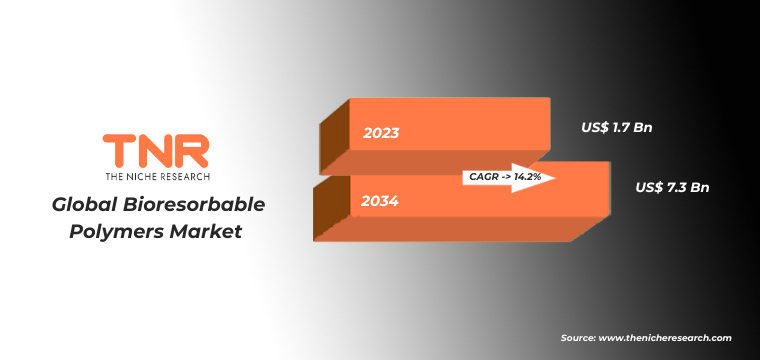
Growth Drivers of Global Bioresorbable Polymers Market
- Growing Demand for Advanced Medical Devices: These materials are increasingly used in applications such as stents, sutures, and orthopedic implants, where their ability to degrade safely within the body eliminates the need for additional surgical procedures to remove them. This attribute not only enhances patient comfort but also reduces healthcare costs and recovery times. For instance, in August 2021, Evonik Industries AG acquired JeNaCell, a German biotech firm, to enhance its range of biomaterials in the healthcare sector. This acquisition will support the transformation of Evonik’s Nutrition & Care division towards offering system solutions and will broaden the division’s portfolio of natural products for the medical technology platform. The aging global population, coupled with the rising prevalence of chronic diseases, is escalating the number of surgical interventions. Consequently, healthcare providers and patients are increasingly favoring bioresorbable solutions that offer improved outcomes and reduced risks, thereby driving market growth.
- Technological Advancements and R&D: Continuous technological advancements and significant R&D investments are propelling the bioresorbable polymers market forward. Innovations in polymer science have led to the development of new materials with enhanced mechanical properties, better biocompatibility, and controlled degradation rates. These advancements are expanding the applications of bioresorbable polymers beyond traditional uses into areas such as tissue engineering, drug delivery systems, and regenerative medicine. Furthermore, collaborations between academic institutions, research organizations, and industry players are fostering the creation of cutting-edge solutions that address unmet medical needs. This dynamic R&D ecosystem is crucial in accelerating the adoption of bioresorbable polymers and unlocking new market opportunities.
Synthetic by origin category have emerged as a dominant segment in the global bioresorbable polymers market due to its superior control over material properties and consistent quality.
Synthetic bioresorbable polymers, such as polylactic acid (PLA), polyglycolic acid (PGA), and polycaprolactone (PCL), offer tailored degradation rates, mechanical strength, and biocompatibility, making them highly suitable for a wide range of medical applications. Their versatility allows for precise engineering to meet specific clinical requirements, which is critical in applications like sutures, orthopedic implants, and drug delivery systems. Additionally, the reproducibility and scalability of synthetic polymers facilitate large-scale manufacturing, ensuring a steady supply to meet the growing demand in the healthcare industry. The reliability and adaptability of synthetic bioresorbable polymers position them as a preferred choice, driving their dominance in the market.
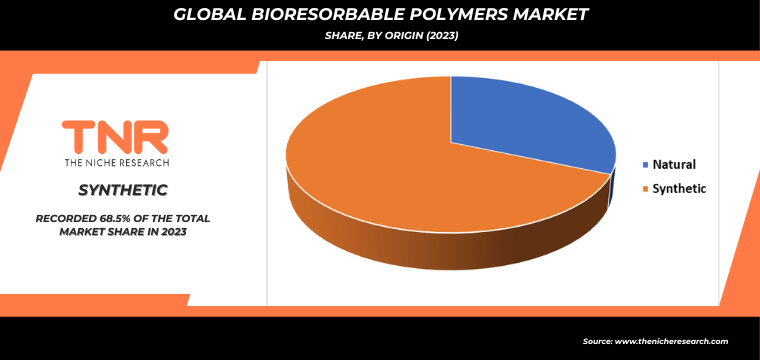
In 2023, polyglycolic acid (PGA) segment solidified its position as the second-largest type category within the global bioresorbable polymers market.
PGA’s prominence is attributed to its exceptional biodegradability, high tensile strength, and proven biocompatibility, making it an ideal material for various medical applications. Its rapid degradation rate is particularly advantageous in surgical sutures, where quick absorption is required to minimize patient discomfort and eliminate the need for suture removal. Additionally, PGA’s utility extends to tissue engineering and regenerative medicine, where its properties support effective scaffold formation and tissue regeneration. The consistent demand for high-performance, bioresorbable materials in these advanced medical fields has propelled the growth of the PGA segment, underscoring its vital role and substantial market share in the evolving bioresorbable polymers industry.
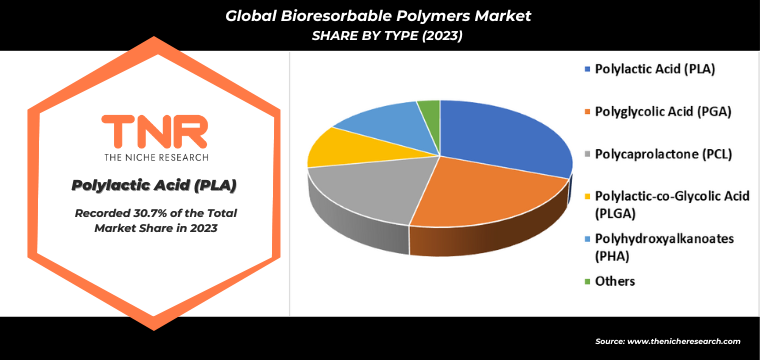
Medical devices segment by application dominated the global Bioresorbable polymers market in 2023 with a CAGR of 6.8%. This segment’s dominance is driven by the increasing utilization of bioresorbable polymers in advanced medical devices, including sutures, stents, and orthopedic implants. These materials offer significant advantages, such as eliminating the need for secondary surgeries to remove implants, reducing patient recovery times, and minimizing long-term complications. The growing prevalence of chronic diseases and the aging population have escalated the demand for minimally invasive surgical procedures, further boosting the adoption of bioresorbable medical devices. Continuous technological advancements and R&D investments are enhancing the performance and application range of these polymers, cementing the medical devices segment’s leading position in the market.
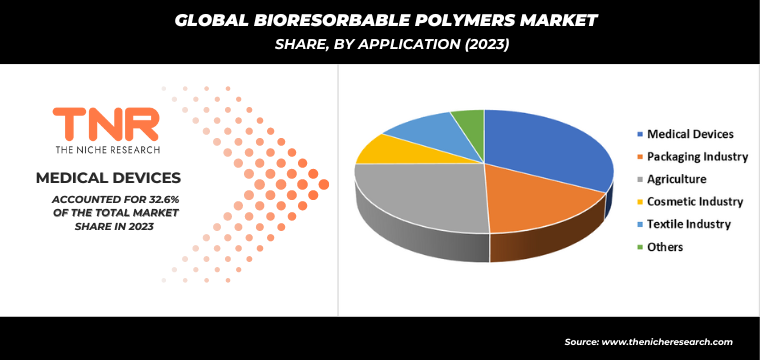
In 2023, North America solidified its dominance in the global bioresorbable polymers market, contributing a revenue share of 33.3%. This leadership position is attributed to several factors, including the region’s advanced healthcare infrastructure, high adoption rates of innovative medical technologies, and significant investment in research and development. The presence of major market players and numerous biotech firms in the U.S. and Canada also fuels growth, enabling rapid advancements and commercialization of bioresorbable polymer-based products. Additionally, favorable regulatory frameworks and supportive reimbursement policies encourage the widespread use of these materials in medical applications. The increasing prevalence of chronic diseases and a growing aging population further drive demand for bioresorbable medical devices, ensuring North America’s continued dominance in this expanding market.
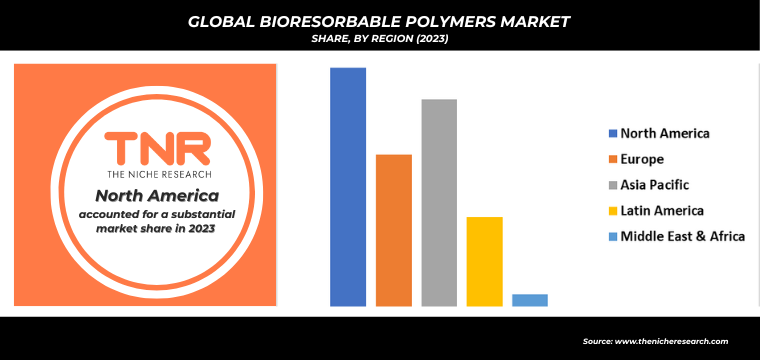
Competitive Landscape
Some of the players operating in the bioresorbable polymers market are
- 3D Biotek LLC.
- Abbott
- Braskem
- Cardia Bioplastics
- Corbion
- Danimer Scientific
- DSM
- Evonik Industries AG
- Foster Corporation
- Futerro
- Green Dot Bioplastics
- KLS Martin Group
- Poly-Med Incorporated
- Sunstar Suisse S.A.
- Other Industry Participants
Global Bioresorbable Polymers Market Scope
| Report Specifications | Details |
| Market Revenue in 2023 | US$ 1.7 Bn |
| Market Size Forecast by 2034 | US$ 7.3 Bn |
| Growth Rate (CAGR) | 14.2% |
| Historic Data | 2016 – 2022 |
| Base Year for Estimation | 2023 |
| Forecast Period | 2024 – 2034 |
| Report Inclusions | Market Size & Estimates, Market Dynamics, Competitive Scenario, Trends, Growth Factors, Market Determinants, Key Investment Segmentation, Product/Service/Solutions Benchmarking |
| Segments Covered | By Origin, By Type, By Application, By Region |
| Regions Covered | North America, Europe, Asia Pacific, Middle East & Africa, Latin America |
| Countries Covered | U.S., Canada, Mexico, Rest of North America, France, The UK, Spain, Germany, Italy, Nordic Countries (Denmark, Finland, Iceland, Sweden, Norway), Benelux Union (Belgium, The Netherlands, Luxembourg), Rest of Europe, China, Japan, India, New Zealand, Australia, South Korea, Southeast Asia (Indonesia, Thailand, Malaysia, Singapore, Rest of Southeast Asia), Rest of Asia Pacific, Saudi Arabia, UAE, Egypt, Kuwait, South Africa, Rest of Middle East & Africa, Brazil, Argentina, Rest of Latin America |
| Key Players | 3D Biotek LLC., Abbott, Braskem, Cardia Bioplastics, Corbion, Danimer Scientific, DSM, Evonik Industries AG, Foster Corporation, Futerro, Green Dot Bioplastics, KLS Martin Group, Poly-Med Incorporated, Sunstar Suisse S.A. |
| Customization Scope | Customization allows for the inclusion/modification of content pertaining to geographical regions, countries, and specific market segments. |
| Pricing & Procurement Options | Explore purchase options tailored to your specific research requirements |
| Contact Details | Consult With Our Expert
Japan (Toll-Free): +81 663-386-8111 South Korea (Toll-Free): +82-808- 703-126 Saudi Arabia (Toll-Free): +966 800-850-1643 United Kingdom: +44 753-710-5080 United States: +1 302-232-5106 E-mail: askanexpert@thenicheresearch.com
|
Global Bioresorbable Polymers Market
By Origin
- Natural
- Synthetic
By Type
- Polylactic Acid (PLA)
- PDLLA (poly DL-lactic acid)
- PLLA (poly (L-lactic acid)
- PDLA (poly (D-lactic acid)
- Polyglycolic Acid (PGA)
- Polycaprolactone (PCL)
- Polylactic-co-Glycolic Acid (PLGA)
- Polyhydroxyalkanoates (PHA)
- Others
By Application
- Medical Devices
- Sutures
- Stents
- Orthopedic devices
- Tissue engineering scaffolds
- Drug delivery systems
- Others
- Packaging Industry
- Agriculture
- Controlled-release fertilizers
- Plant pots and trays
- Others
- Cosmetic Industry
- Textile Industry
- Others
By Region
- North America (U.S., Canada, Mexico, Rest of North America)
- Europe (France, The UK, Spain, Germany, Italy, Nordic Countries (Denmark, Finland, Iceland, Sweden, Norway), Benelux Union (Belgium, The Netherlands, Luxembourg), Rest of Europe)
- Asia Pacific (China, Japan, India, New Zealand, Australia, South Korea, Southeast Asia (Indonesia, Thailand, Malaysia, Singapore, Rest of Southeast Asia), Rest of Asia Pacific)
- Middle East & Africa (Saudi Arabia, UAE, Egypt, Kuwait, South Africa, Rest of Middle East & Africa)
- Latin America (Brazil, Argentina, Rest of Latin America)
Report Layout:
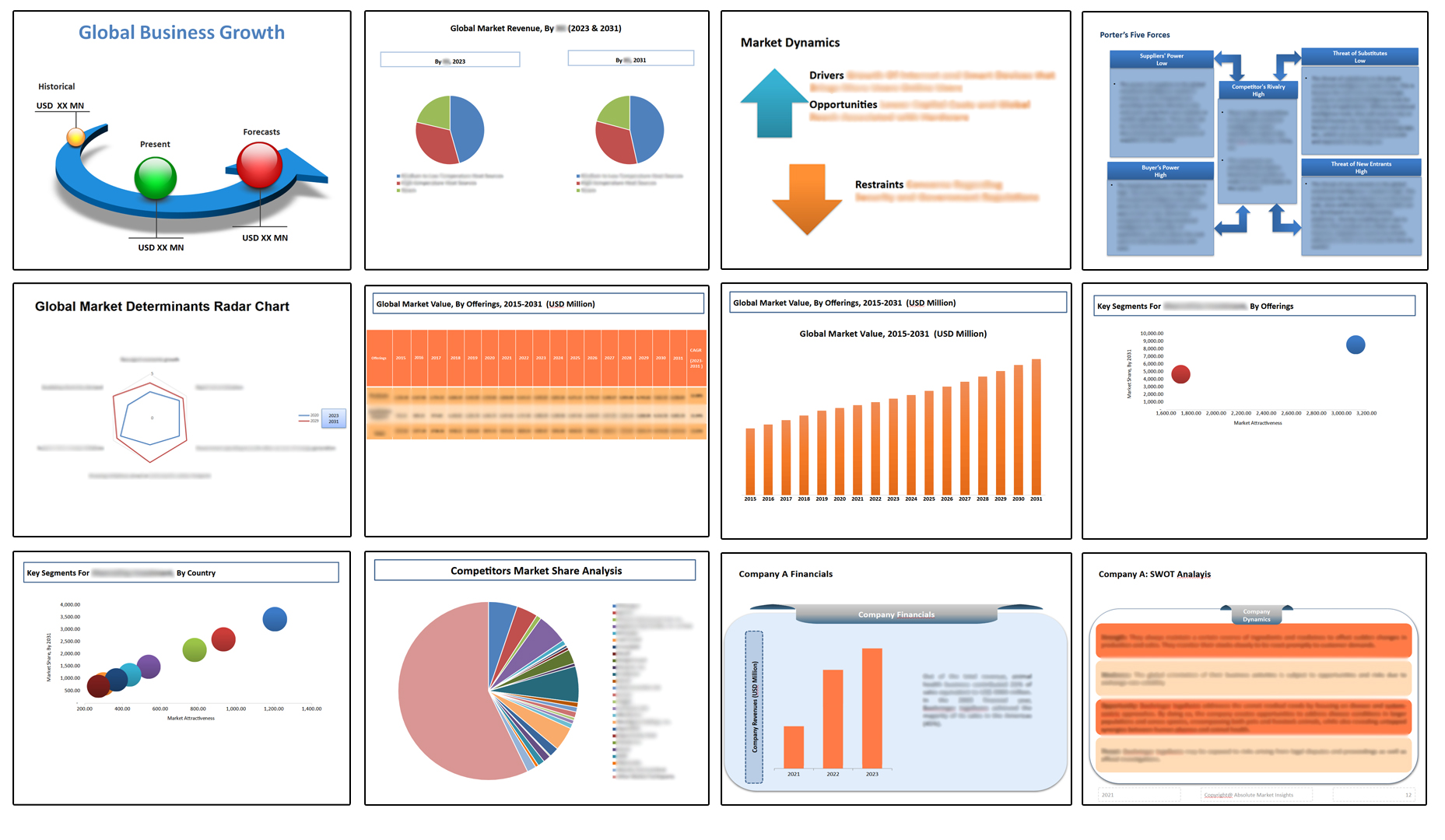
Table of Contents
Note: This ToC is tentative and can be changed according to the research study conducted during the course of report completion.
**Exclusive for Multi-User and Enterprise User.
Global Bioresorbable Polymers Market
By Origin
- Natural
- Synthetic
By Type
- Polylactic Acid (PLA)
- PDLLA (poly DL-lactic acid)
- PLLA (poly (L-lactic acid)
- PDLA (poly (D-lactic acid)
- Polyglycolic Acid (PGA)
- Polycaprolactone (PCL)
- Polylactic-co-Glycolic Acid (PLGA)
- Polyhydroxyalkanoates (PHA)
- Others
By Application
- Medical Devices
- Sutures
- Stents
- Orthopedic devices
- Tissue engineering scaffolds
- Drug delivery systems
- Others
- Packaging Industry
- Agriculture
- Controlled-release fertilizers
- Plant pots and trays
- Others
- Cosmetic Industry
- Textile Industry
- Others
By Region
- North America (U.S., Canada, Mexico, Rest of North America)
- Europe (France, The UK, Spain, Germany, Italy, Nordic Countries (Denmark, Finland, Iceland, Sweden, Norway), Benelux Union (Belgium, The Netherlands, Luxembourg), Rest of Europe)
- Asia Pacific (China, Japan, India, New Zealand, Australia, South Korea, Southeast Asia (Indonesia, Thailand, Malaysia, Singapore, Rest of Southeast Asia), Rest of Asia Pacific)
- Middle East & Africa (Saudi Arabia, UAE, Egypt, Kuwait, South Africa, Rest of Middle East & Africa)
- Latin America (Brazil, Argentina, Rest of Latin America)
The Niche Research approach encompasses both primary and secondary research methods to provide comprehensive insights. While primary research is the cornerstone of our studies, we also incorporate secondary research sources such as company annual reports, premium industry databases, press releases, industry journals, and white papers.
Within our primary research, we actively engage with various industry stakeholders, conducting paid interviews and surveys. Our meticulous analysis extends to every market participant in major countries, allowing us to thoroughly examine their portfolios, calculate market shares, and segment revenues.
Our data collection primarily focuses on individual countries within our research scope, enabling us to estimate regional market sizes. Typically, we employ a bottom-up approach, meticulously tracking trends in different countries. We analyze growth drivers, constraints, technological innovations, and opportunities for each country, ultimately arriving at regional figures.Our process begins by examining the growth prospects of each country. Building upon these insights, we project growth and trends for the entire region. Finally, we utilize our proprietary model to refine estimations and forecasts.
Our data validation standards are integral to ensuring the reliability and accuracy of our research findings. Here’s a breakdown of our data validation processes and the stakeholders we engage with during our primary research:
- Supply Side Analysis: We initiate a supply side analysis by directly contacting market participants, through telephonic interviews and questionnaires containing both open-ended and close-ended questions. We gather information on their portfolios, segment revenues, developments, and growth strategies.
- Demand Side Analysis: To gain insights into adoption trends and consumer preferences, we reach out to target customers and users (non-vendors). This information forms a vital part of the qualitative analysis section of our reports, covering market dynamics, adoption trends, consumer behavior, spending patterns, and other related aspects.
- Consultant Insights: We tap into the expertise of our partner consultants from around the world to obtain their unique viewpoints and perspectives. Their insights contribute to a well-rounded understanding of the markets under investigation.
- In-House Validation: To ensure data accuracy and reliability, we conduct cross-validation of data points and information through our in-house team of consultants and utilize advanced data modeling tools for thorough verification.
The forecasts we provide are based on a comprehensive assessment of various factors, including:
- Market Trends and Past Performance (Last Five Years): We accurately analyze market trends and performance data from preceding five years to identify historical patterns and understand the market’s evolution.
- Historical Performance and Growth of Market Participants: We assess the historical performance and growth trajectories of key market participants. This analysis provides insights into the competitive landscape and individual company strategies.
- Market Determinants Impact Analysis (Next Eight Years): We conduct a rigorous analysis of the factors that are projected to influence the market over the next eight years. This includes assessing both internal and external determinants that can shape market dynamics.
- Drivers and Challenges for the Forecast Period:Identify the factors expected to drive market growth during the forecast period, as well as the challenges that the industry may face. This analysis aids in deriving an accurate growth rate projection.
- New Acquisitions, Collaborations, or Partnerships: We keep a close watch on any new acquisitions, collaborations, or partnerships within the industry. These developments can have a significant impact on market dynamics and competitiveness.
- Macro and Micro Factors Analysis:A thorough examination of both macro-level factors (e.g., economic trends, regulatory changes) and micro-level factors (e.g., technological advancements, consumer preferences) that may influence the market during the forecast period.
- End-User Sentiment Analysis: To understand the market from the end-user perspective, we conduct sentiment analysis. This involves assessing the sentiment, preferences, and feedback of the end-users, which can provide valuable insights into market trends.
- Perspective of Primary Participants: Insights gathered directly from primary research participants play a crucial role in shaping our forecasts. Their perspectives and experiences provide valuable qualitative data.
- Year-on-Year Growth Trend: We utilize a year-on-year growth trend based on historical market growth and expected future trends. This helps in formulating our growth projections, aligning them with the market’s historical performance.
Research process adopted by TNR involves multiple stages, including data collection, validation, quality checks, and presentation. It’s crucial that the data and information we provide add value to your existing market understanding and expertise. We have also established partnerships with business consulting, research, and survey organizations across regions and globally to collaborate on regional analysis and data validation, ensuring the highest level of accuracy and reliability in our reports.















